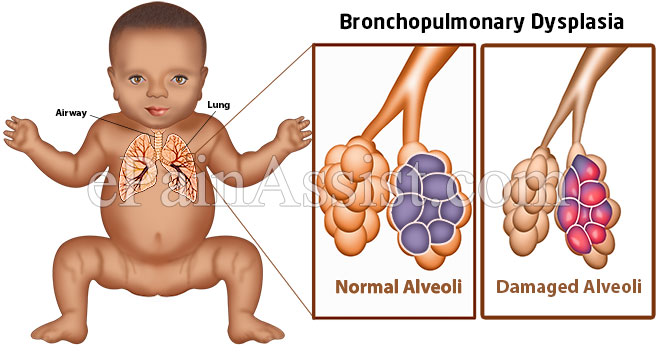What is Bronchopulmonary Dysplasia?
Bronchopulmonary Dysplasia is a pathological condition seen in infants who are born premature with underdeveloped lungs. When these infants are treated for underdeveloped lungs and provided pressurized oxygen through machines in some cases the airways which are in the process of being developed get damaged resulting in what is termed as Respiratory Distress Syndrome. Normally, the Respiratory Distress Syndrome clears up within a month as the infant grows but if this is not the case then it gives rise to another condition known as Bronchopulmonary Dysplasia.
Infants with Bronchopulmonary Dysplasia tend to have lung scarring. This condition is benign and in majority of the cases the infants outgrow this condition. Only in rare cases has Bronchopulmonary Dysplasia been proved to be lethal.

What Causes Bronchopulmonary Dysplasia?
As stated, Bronchopulmonary Dysplasia develops due to aggravation of Respiratory Distress Syndrome which is a condition caused due to an underdeveloped lung in an infant. The lungs of some premature babies are not able to make sufficient surfactant which is a liquid which forms a coating on the inside part of the lungs and allows it to stay open. This is the reason why such infants need to be put on artificial respiration because of which they develop respiratory distress syndrome which ultimately causes Bronchopulmonary Dysplasia.
What are the Risk Factors for Bronchopulmonary Dysplasia?
Speaking of risk factors for Bronchopulmonary Dysplasia, it is the premature babies or babies who are born with significantly low weight that are at risk for developing Bronchopulmonary Dysplasia since they do not have fully developed lungs when they are born. Full-term babies with certain lung infections or other lung issues may also be at risk for Bronchopulmonary Dysplasia.
What are the Symptoms of Bronchopulmonary Dysplasia?
Some of the symptoms of Bronchopulmonary Dysplasia are:
- Skin discoloration with the skin turning bluish
- Rapid breathing
- Coughing
- Wheezing
- Problems with feeding
- Frequent episodes of vomiting.
How is Bronchopulmonary Dysplasia Diagnosed?
The diagnosis of Bronchopulmonary Dysplasia is quite easy if the baby is premature and has been dealing with respiratory distress syndrome for more than a month in duration. To confirm the diagnosis, radiological studies may be done in the form of x-ray of the chest which may reveal a spongy lung confirming the diagnosis of Bronchopulmonary Dysplasia. Blood work may also be done to check the amount of oxygen in the blood which will obviously be low in the case of Bronchopulmonary Dysplasia and hence confirm the diagnosis of Bronchopulmonary Dysplasia.
How is Bronchopulmonary Dysplasia Treated?
To begin with, the infant suffering from Bronchopulmonary Dysplasia will be put in an incubator to prevent the baby from infections till they are developed enough to breathe on their own. Continuous oxygen will be supplied through a ventilator. As and when the doctor feels that the child’s lungs have developed through serial imaging studies, he or she will start to slowly wean the baby off of the ventilator.
The baby may also be treated with bronchodilators for Bronchopulmonary Dysplasia as these medications help in keeping the airways open. The baby will also be given diuretics to prevent fluid build up in the lungs. The baby will also be on antibiotics to prevent any infection as babies with Bronchopulmonary Dysplasia are prone to lung infections like pneumonia. The baby may also be given short doses of steroids for inflammation. On an average, it takes about four to five months for the child to stay in the NICU before the child is fit enough to go home and be declared as being treated from Bronchopulmonary Dysplasia.
What is the Prognosis of Bronchopulmonary Dysplasia?
As stated Bronchopulmonary Dysplasia is a benign condition and in majority of the cases, babies grow out of this condition but in some cases there may be some complications such as fluid buildup in the lungs or food getting into the lungs. Once discharged from hospital, it is essential for the baby to be given a clean environment free from any dust or other allergens. It is also extremely vital for the child to be protected from any potential bacteria or virus, so the parents should make sure that anyone who goes close to the baby uses hand sanitizer or gloves before touching the baby so as to prevent any infection after being treated for Bronchopulmonary Dysplasia.
